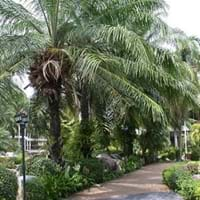Life Span
Perennial
Annual
Type
Perennial
Palm or Cycad
Origin
Eastern Europe
Eastern Africa, Northern Africa, Middle Africa
Types
Not Available
Not Available
Habitat
Terrestrial
Forest edges
USDA Hardiness Zone
4-9
10-15
Sunset Zone
1a, 1b, 2a, 2b, 3a, 3b, 4, 5, 6, 7, 8, 9, 10, 11, 12, 13, 14, 15, 16, 17, 18, 19, 20, 21, 22, 23, 24
Not available
Habit
Clump-Forming
Upright/Erect
Flower Color
Yellow, Lavender, Blue Violet
Ivory
Flower Color Modifier
Bicolor
Bicolor
Fruit Color
Not Available
Orange
Leaf Color in Spring
Green, Sea Green
Green, Dark Green
Leaf Color in Summer
Green, Sea Green
Green, Dark Green
Leaf Color in Fall
Green, Sea Green
Green, Dark Green
Leaf Color in Winter
Light Green
Green, Dark Green
Leaf Shape
Lanceolate
Long Linear
Plant Season
Spring, Summer
Spring, Summer, Fall, Winter
Sunlight
Full Sun, Partial Sun
Full Sun
Growth Rate
Medium
Medium
Type of Soil
Loam, Sand
Loam, Sand
The pH of Soil
Neutral
Acidic, Neutral
Soil Drainage
Well drained
Well drained
Bloom Time
Spring, Late Spring, Early Summer
Indeterminate
Tolerances
Drought
Not Available
Where to Plant?
Ground
Ground
How to Plant?
By dividing rhizomes, tubers, Seedlings
Seedlings, Transplanting
Plant Maintenance
Medium
Medium
Watering Requirements
Average Water Needs, Do Not over Water
Does not require lot of watering, Use and maintain water-efficient soaker hoses, Use Mulches to help prevent water loss during hot and windy weather, Water in morning to avoid prompting diseases, Water twice a day in the initial period
In Summer
Lots of watering
Lots of watering
In Spring
Moderate
Moderate
In Winter
Average Water
Average Water
Soil pH
Neutral
Acidic, Neutral
Soil Type
Loam, Sand
Loam, Sand
Soil Drainage Capacity
Well drained
Well drained
Sun Exposure
Full Sun, Partial Sun
Full Sun
Pruning
Remove damaged leaves, Remove dead branches, Remove dead leaves
Cut or pinch the stems, Prune for shortening long shoots, Remove dead or diseased plant parts
Fertilizers
All-Purpose Liquid Fertilizer
All-Purpose Liquid Fertilizer
Pests and Diseases
Red blotch
Red blotch
Plant Tolerance
Drought
Drought
Flowers
Yes
Insignificant
Flower Petal Number
Single
Single
Foliage Texture
Coarse
Bold
Foliage Sheen
Matte
Matte
Attracts
Hummingbirds
Birds
Allergy
Skin irritation
Asthma
Aesthetic Uses
Showy Purposes
Showy Purposes
Beauty Benefits
Not Available
Not Available
Environmental Uses
Air purification
Air purification
Medicinal Uses
No Medicinal Use
High blood pressure, High cholestrol, Malaria, Weight loss
Part of Plant Used
Not Available
Whole plant
Other Uses
Used as Ornamental plant
Used As Food, Used for producing cooking oil
Used As Indoor Plant
No
No
Used As Outdoor Plant
Yes
Yes
Garden Design
Alpine, Edging, Mixed Border, Rock Garden, Wall
Feature Plant, Shade Trees, Street Trees, Tropical
Botanical Name
IRIS pumila
ELAEIS guineensis
Common Name
Dwarf Iris
African Oil Palm
In Hindi
Dwarf Iris
अफ्रीकी ऑयल पाम
In German
Zwergiris
African Oil Palm
In French
Dwarf Iris
L'huile de palme africaine
In Spanish
Enano Iris
Aceite de Palma Africana
In Greek
νάνος Ίρις
Αφρικανική φοινικέλαιο
In Portuguese
Dwarf Iris
Óleo de palma Africano
In Polish
Dwarf Iris
Afrykański Olej palmowy
In Latin
Iris Dwarf
African Oil Palm
Phylum
Magnoliophyta
Not Available
Class
Liliopsida
Liliopsida
Family
Iridaceae
Arecaceae
Clade
Angiosperms, Monocots
Not Available
Subfamily
Iridoideae
Arecoideae
Number of Species
Not Available
Not Available
Difference Between Dwarf Iris and African Oil Palm
If you are confused whether Dwarf Iris or African Oil Palm are same, here are some features about those plants to help you choose better. Many people think that these two plants have the same characteristics, but one can see Dwarf Iris and African Oil Palm Information and learn more about it. Fertilizers required for proper growth of Dwarf Iris are All-Purpose Liquid Fertilizer, whereas for African Oil Palm fertilizers required are All-Purpose Liquid Fertilizer. Hence, one should know the basic difference between Dwarf Iris and African Oil Palm if you are planning to have them in your garden to enhance its beauty.
<
Flowering PlantsImportance of Dwarf Iris and African Oil Palm
Want to have the most appropriate plant for your garden? You might want to know the importance of Dwarf Iris and African Oil Palm. Basically, these two plants vary in many aspects. Compare Dwarf Iris and African Oil Palm as they differ in many characteristics such as their life, care, benefits, facts, etc. Every gardener must at least have the slightest clue about the plants he wants to plant in his garden. Compare their benefits, which differ in many ways like facts and uses. The medicinal use of Dwarf Iris is No Medicinal Use whereas of African Oil Palm is High blood pressure, High cholestrol, Malaria and Weight loss. Dwarf Iris has beauty benefits as follows: Not Available while African Oil Palm has beauty benefits as follows: Not Available.
Compare Facts of Dwarf Iris vs African Oil Palm
How to choose the best garden plant for your garden depending upon its facts? Here garden plant comparison will help you to solve this query. Compare the facts of Dwarf Iris vs African Oil Palm and know which one to choose. As garden plants have benefits and other uses, allergy is also a major drawback of plants for some people. Allergic reactions of Dwarf Iris are Skin irritation whereas of African Oil Palm have Asthma respectively. Having a fruit bearing plant in your garden can be a plus point of your garden. Dwarf Iris has no showy fruits and African Oil Palm has showy fruits. Also Dwarf Iris is flowering and African Oil Palm is not flowering . You can compare Dwarf Iris and African Oil Palm facts and facts of other plants too.





